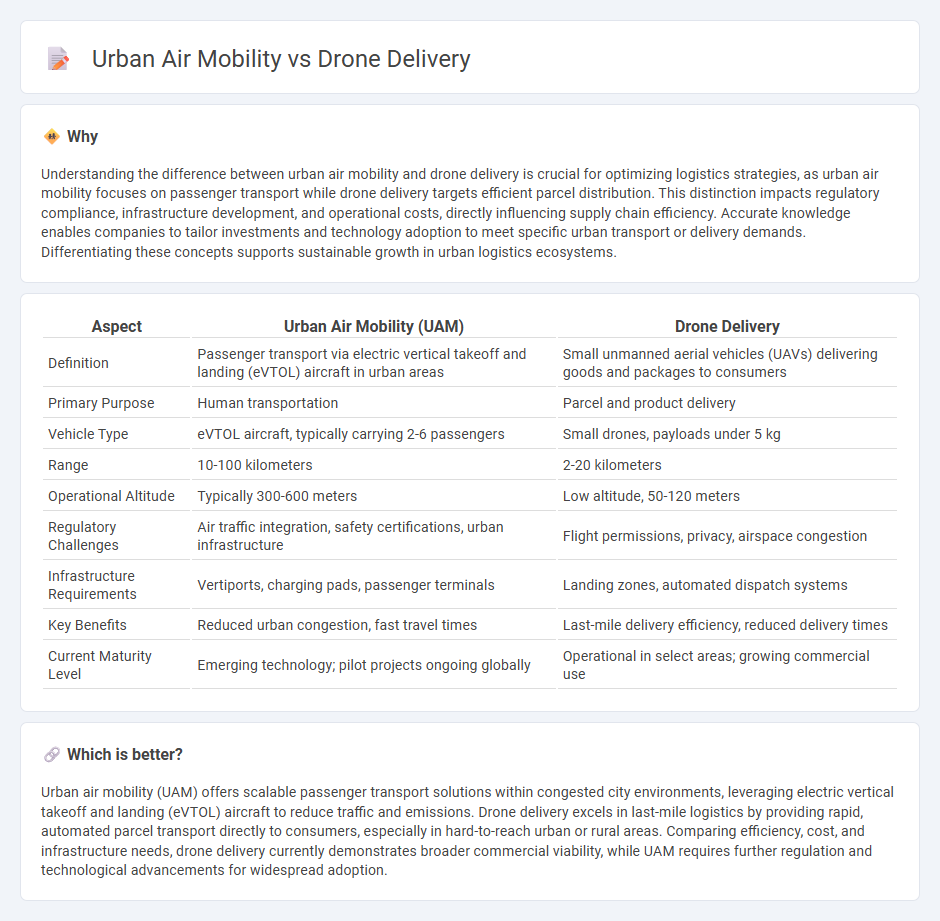
Urban air mobility focuses on the efficient transport of passengers through aerial vehicles within city environments, aiming to reduce ground congestion and travel times. In contrast, drone delivery specializes in the autonomous transport of goods, offering rapid and precise parcel distribution for e-commerce and medical supplies. Explore the advancements and impacts of these transformative logistics solutions in urban settings.
Why it is important
Understanding the difference between urban air mobility and drone delivery is crucial for optimizing logistics strategies, as urban air mobility focuses on passenger transport while drone delivery targets efficient parcel distribution. This distinction impacts regulatory compliance, infrastructure development, and operational costs, directly influencing supply chain efficiency. Accurate knowledge enables companies to tailor investments and technology adoption to meet specific urban transport or delivery demands. Differentiating these concepts supports sustainable growth in urban logistics ecosystems.
Comparison Table
| Aspect | Urban Air Mobility (UAM) | Drone Delivery |
|---|---|---|
| Definition | Passenger transport via electric vertical takeoff and landing (eVTOL) aircraft in urban areas | Small unmanned aerial vehicles (UAVs) delivering goods and packages to consumers |
| Primary Purpose | Human transportation | Parcel and product delivery |
| Vehicle Type | eVTOL aircraft, typically carrying 2-6 passengers | Small drones, payloads under 5 kg |
| Range | 10-100 kilometers | 2-20 kilometers |
| Operational Altitude | Typically 300-600 meters | Low altitude, 50-120 meters |
| Regulatory Challenges | Air traffic integration, safety certifications, urban infrastructure | Flight permissions, privacy, airspace congestion |
| Infrastructure Requirements | Vertiports, charging pads, passenger terminals | Landing zones, automated dispatch systems |
| Key Benefits | Reduced urban congestion, fast travel times | Last-mile delivery efficiency, reduced delivery times |
| Current Maturity Level | Emerging technology; pilot projects ongoing globally | Operational in select areas; growing commercial use |
Which is better?
Urban air mobility (UAM) offers scalable passenger transport solutions within congested city environments, leveraging electric vertical takeoff and landing (eVTOL) aircraft to reduce traffic and emissions. Drone delivery excels in last-mile logistics by providing rapid, automated parcel transport directly to consumers, especially in hard-to-reach urban or rural areas. Comparing efficiency, cost, and infrastructure needs, drone delivery currently demonstrates broader commercial viability, while UAM requires further regulation and technological advancements for widespread adoption.
Connection
Urban air mobility (UAM) enhances logistics by enabling fast, efficient drone delivery within congested city environments. Utilizing electric vertical takeoff and landing (eVTOL) aircraft, UAM integrates aerial routes that reduce delivery times and alleviate ground traffic congestion. This synergy supports last-mile logistics solutions, optimizing supply chain efficiency in urban areas.
Key Terms
Last-mile delivery
Drone delivery revolutionizes last-mile delivery by enabling rapid, contactless transport of small parcels directly to consumers, reducing traffic congestion and delivery times in urban environments. Urban air mobility (UAM) encompasses a broader spectrum, including passenger transport and larger cargo, but faces regulatory and infrastructure challenges that limit its immediate impact on last-mile logistics. Explore the latest advancements and strategies shaping the future of last-mile delivery through drone technology and urban air mobility.
Vertiport infrastructure
Vertiport infrastructure plays a crucial role in the deployment of both drone delivery systems and urban air mobility (UAM), requiring advanced design to support vertical takeoff and landing operations. Drone delivery often demands compact, distributed vertiports integrated into urban landscapes, while UAM necessitates larger, more complex hubs capable of handling passenger traffic and regulatory compliance. Explore further to understand how vertiport innovations are shaping the future of aerial logistics and urban transportation.
Payload capacity
Drone delivery systems typically support payload capacities ranging from 2 to 5 kilograms, making them ideal for small packages and lightweight goods. Urban Air Mobility (UAM) vehicles, designed for passenger transport, offer significantly higher payload capacities, often exceeding 500 kilograms, enabling them to carry multiple passengers or larger cargo loads. Explore detailed comparisons and payload specifications to understand the evolving landscape of aerial logistics and transportation.
Source and External Links
Delivery drone - Delivery drones are unmanned aerial vehicles designed to transport packages, medicines, foods, and other light goods, operated autonomously or semi-autonomously; they are used by companies like Amazon and DHL and have been critical in medical delivery during COVID-19, with configurations including multirotor, fixed-wing, and hybrid designs.
Amazon's drones can now deliver iPhones. Here's how it ... - Amazon's drone delivery service has advanced with new technology allowing precise delivery within designated zones and points, streamlining the process without physical QR codes and enabling fast, accurate arrivals with notifications to customers.
A2Z Drone Delivery | Advanced Drone Delivery Technology - A2Z provides specialized drone technology for last-mile delivery, industrial transport, medical delivery, and search and rescue, featuring drones with extended range and automatic charging infrastructure designed for swift and efficient operations across diverse sectors.
 dowidth.com
dowidth.com